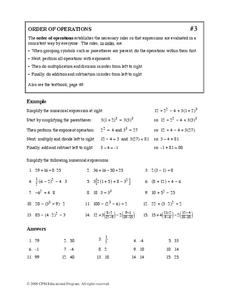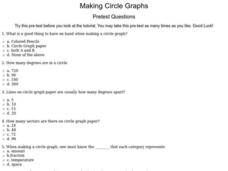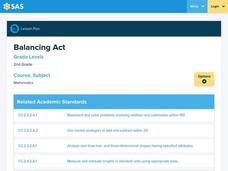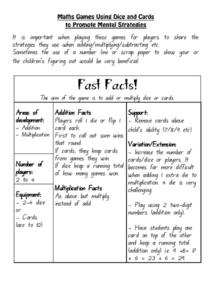Curated OER
Tracking the Salt Front
Using the Hudson River as the focus, learners discuss the difference between salt water and fresh water environments, analyze maps and graphs, and complete addition and subtraction problems. This lesson comes with a wealth of...
Curated OER
Primary Understanding and Use of Place Value
Explore place value and regrouping with your class. They develop awareness of several ancient number systems and how they differ from the base ten system commonly used today. They play "Chip Trading" with partners to practice addition...
Curated OER
Introduction to Exponents
Problem solve using exponents. Pupils read One Grain of Rice: A Mathematical Folktale and write powers to represent amounts from the story.They compare actual solutions to their predictions and play a game to practice using...
Armory Center for the Arts
Place Value Collage
How can art represent math? Use a lesson on place value collages to illustrate the different meanings that numbers have in their designated places. Kids observe photographs and paintings that show place value, then work on their own.
Curated OER
Counting Back and Counting On
Read aloud your choice of books about counting on and counting back (a list is provided, or tell stories of your own). Your learners will write horizontal equations to portray what happens in the story. They build a paper chain and...
Curated OER
Naming the Pattern
In this pattern activity, 2nd graders complete fifteen number patterns and explain the counting pattern for each group. Students also complete five picture patterns and label each of the patterns.
Alabama Learning Exchange
Fun with Problem Solving
Using a varity of strategies, young mathematicians solve multistep word problems. They play a logic game as a whole group, and then work with a partner on a computer to complete a worksheet that requires a variety of problem solving...
CPM
Order of Operations
Middle schoolers solve problems that include applying the order of operations to each expression. A nice review of the process is provided in a box at the top of the page, but it does not follow the PEMDAS acrostic. There are 15...
Curated OER
Expanded Form and Place Value
Third graders are introduced to the concept of place value with place value tents. As a class, they are shown a number which they say outloud and write the number in expanded form. To end the lesson, they practice saying numbers in the...
Math Mammoth
Percent Fact Sheet
In this math worksheet, students are given 9 percentage problems that involve conversion, variables, story problems and fractions.
Curated OER
Carpentry: merit badge
In this carpentry learning exercise, students fill out short answer questions using their workbook about carpentry in order to get a merit badge. Students complete 6 questions total.
Curated OER
Immigration Unit
Third graders develop an appreciate for the various cultures that are present in their local community. Through reading and research, they explain how various culture came to live in their area. At the conclusion of the unit, 3rd...
Curated OER
Estimating Sums and Differences
In this estimation worksheet, 4th graders estimate the sum or difference of 15 math problems. Students write their answers underneath each math problem on the worksheet.
Curated OER
Making Circle Graphs
In this circle graphing worksheet, 6th graders answer ten multiple choice questions based on their knowledge of circle graphs. This is an interactive worksheet.
Math Mammoth
Number Line Jumps
In this math learning exercise, learners write addition and subtraction sentences for eight word problems involving integers. Students use a number line to find the answer to the problem. Learners complete addition and subtraction with...
Curated OER
Balancing Act
Second graders identify the attributes of various shapes and estimate the weight of the objects. In this geometry lesson, 2nd graders identify the attributes of concrete objects and use a pan balance to weight them.
Curated OER
The Changing Me
Third graders study the human body. For this health lesson, 3rd graders discuss that everyone's body is growing, measure body parts using a tape measure, and color the body worksheet.
Curated OER
Food Pyramid Power: Looking Back and Moving Forward
Students show their knowledge of properties of objects as it pertains to sorting and creating patterns. In this food pyramid power lesson, students show their ability to use whole numbers in different representations by appling...
Curated OER
“I Can” Common Core! 6th Grade Math
Help your sixth graders reach their Common Core math standards by providing them with a checklist of "I can" statements for each standard. As each concept is covered, kids can check it off, as long as they can do what it states.
Curriculum Corner
Order of Operations Task Cards (2)
Young mathematicians use their PEMDAS knowledge to solve 20 different task cards. They evaluate expressions to find the answer of multiplication, division, addition, subtraction, and exponential problems. Then, they record their answers...
Pedago Net
Math Games Using Dice and Cards to Promote Mental Strategies
Develop mental math skills using these fun partner games. Covering basic operations, each one offers differentiation options, extension ideas, and clear directions. Dice or cards is all you'll need to keep kids' attention as they...
Noyce Foundation
Sewing
Sew up your unit on operations with decimals using this assessment task. Young mathematicians use given rules to determine the amount of fabric they need to sew a pair of pants. They must also fill in a partially complete bill for...
Houghton Mifflin Harcourt
Unit 1 Math Vocabulary Cards (Grade 1)
Reinforce mathematical vocabulary with the use of flash cards. Each card showcases a boldly typed word as well as a labeled picture representation of the word. Terms include addition, subtraction, greater than, less than, and more!
Curated OER
Number Word Problems: Working Backwards
In this math learning exercise, students learn to solve word problems by working backwards and turning the operations into their inverse partners. There are 25 questions.























